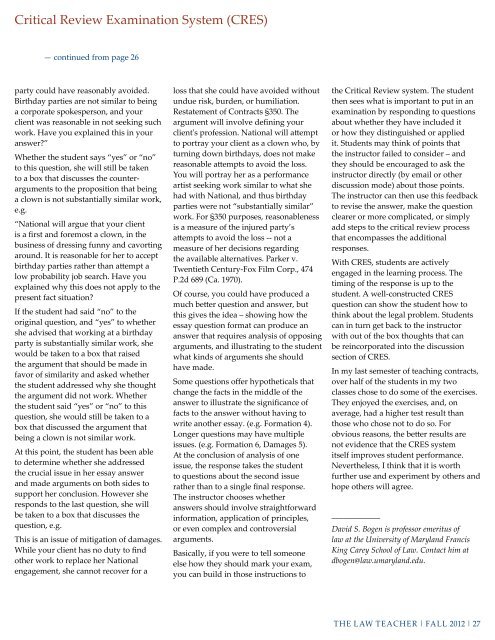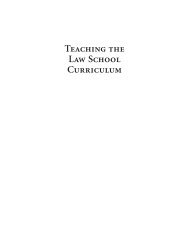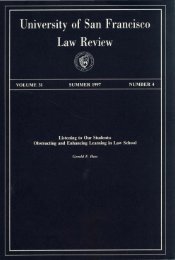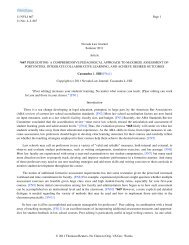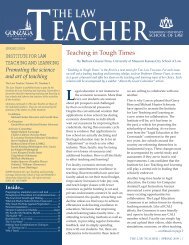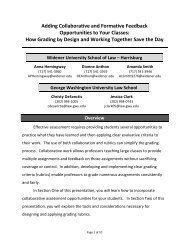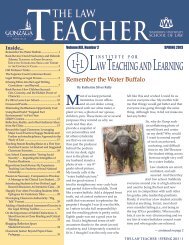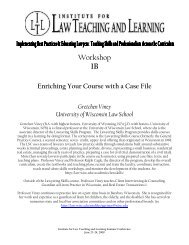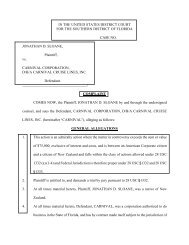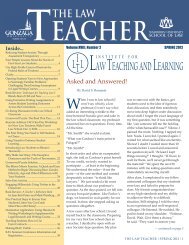The Law Teacher - Institute for Law Teaching and Learning
The Law Teacher - Institute for Law Teaching and Learning
The Law Teacher - Institute for Law Teaching and Learning
Create successful ePaper yourself
Turn your PDF publications into a flip-book with our unique Google optimized e-Paper software.
critical review examination System (creS)<br />
— continued from page 26<br />
party could have reasonably avoided.<br />
Birthday parties are not similar to being<br />
a corporate spokesperson, <strong>and</strong> your<br />
client was reasonable in not seeking such<br />
work. have you explained this in your<br />
answer?”<br />
whether the student says “yes” or “no”<br />
to this question, she will still be taken<br />
to a box that discusses the counterarguments<br />
to the proposition that being<br />
a clown is not substantially similar work,<br />
e.g.<br />
“National will argue that your client<br />
is a first <strong>and</strong> <strong>for</strong>emost a clown, in the<br />
business of dressing funny <strong>and</strong> cavorting<br />
around. It is reasonable <strong>for</strong> her to accept<br />
birthday parties rather than attempt a<br />
low probability job search. have you<br />
explained why this does not apply to the<br />
present fact situation?<br />
If the student had said “no” to the<br />
original question, <strong>and</strong> “yes” to whether<br />
she advised that working at a birthday<br />
party is substantially similar work, she<br />
would be taken to a box that raised<br />
the argument that should be made in<br />
favor of similarity <strong>and</strong> asked whether<br />
the student addressed why she thought<br />
the argument did not work. whether<br />
the student said “yes” or “no” to this<br />
question, she would still be taken to a<br />
box that discussed the argument that<br />
being a clown is not similar work.<br />
at this point, the student has been able<br />
to determine whether she addressed<br />
the crucial issue in her essay answer<br />
<strong>and</strong> made arguments on both sides to<br />
support her conclusion. however she<br />
responds to the last question, she will<br />
be taken to a box that discusses the<br />
question, e.g.<br />
This is an issue of mitigation of damages.<br />
While your client has no duty to find<br />
other work to replace her National<br />
engagement, she cannot recover <strong>for</strong> a<br />
loss that she could have avoided without<br />
undue risk, burden, or humiliation.<br />
restatement of contracts §350. <strong>The</strong><br />
argument will involve defining your<br />
client's profession. National will attempt<br />
to portray your client as a clown who, by<br />
turning down birthdays, does not make<br />
reasonable attempts to avoid the loss.<br />
You will portray her as a per<strong>for</strong>mance<br />
artist seeking work similar to what she<br />
had with National, <strong>and</strong> thus birthday<br />
parties were not “substantially similar”<br />
work. For §350 purposes, reasonableness<br />
is a measure of the injured party’s<br />
attempts to avoid the loss -- not a<br />
measure of her decisions regarding<br />
the available alternatives. Parker v.<br />
Twentieth century-Fox Film corp., 474<br />
P.2d 689 (ca. 1970).<br />
Of course, you could have produced a<br />
much better question <strong>and</strong> answer, but<br />
this gives the idea – showing how the<br />
essay question <strong>for</strong>mat can produce an<br />
answer that requires analysis of opposing<br />
arguments, <strong>and</strong> illustrating to the student<br />
what kinds of arguments she should<br />
have made.<br />
Some questions offer hypotheticals that<br />
change the facts in the middle of the<br />
answer to illustrate the significance of<br />
facts to the answer without having to<br />
write another essay. (e.g. Formation 4).<br />
Longer questions may have multiple<br />
issues. (e.g. Formation 6, Damages 5).<br />
at the conclusion of analysis of one<br />
issue, the response takes the student<br />
to questions about the second issue<br />
rather than to a single final response.<br />
<strong>The</strong> instructor chooses whether<br />
answers should involve straight<strong>for</strong>ward<br />
in<strong>for</strong>mation, application of principles,<br />
or even complex <strong>and</strong> controversial<br />
arguments.<br />
Basically, if you were to tell someone<br />
else how they should mark your exam,<br />
you can build in those instructions to<br />
the critical review system. <strong>The</strong> student<br />
then sees what is important to put in an<br />
examination by responding to questions<br />
about whether they have included it<br />
or how they distinguished or applied<br />
it. Students may think of points that<br />
the instructor failed to consider – <strong>and</strong><br />
they should be encouraged to ask the<br />
instructor directly (by email or other<br />
discussion mode) about those points.<br />
<strong>The</strong> instructor can then use this feedback<br />
to revise the answer, make the question<br />
clearer or more complicated, or simply<br />
add steps to the critical review process<br />
that encompasses the additional<br />
responses.<br />
with creS, students are actively<br />
engaged in the learning process. <strong>The</strong><br />
timing of the response is up to the<br />
student. a well-constructed creS<br />
question can show the student how to<br />
think about the legal problem. Students<br />
can in turn get back to the instructor<br />
with out of the box thoughts that can<br />
be reincorporated into the discussion<br />
section of creS.<br />
In my last semester of teaching contracts,<br />
over half of the students in my two<br />
classes chose to do some of the exercises.<br />
<strong>The</strong>y enjoyed the exercises, <strong>and</strong>, on<br />
average, had a higher test result than<br />
those who chose not to do so. For<br />
obvious reasons, the better results are<br />
not evidence that the creS system<br />
itself improves student per<strong>for</strong>mance.<br />
Nevertheless, I think that it is worth<br />
further use <strong>and</strong> experiment by others <strong>and</strong><br />
hope others will agree.<br />
____________<br />
David S. Bogen is professor emeritus of<br />
law at the University of Maryl<strong>and</strong> Francis<br />
King Carey School of <strong>Law</strong>. Contact him at<br />
dbogen@law.umaryl<strong>and</strong>.edu.<br />
<strong>The</strong> <strong>Law</strong> <strong>Teacher</strong> | FaLL 2012 | 27


